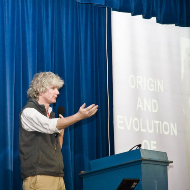It’s not only important to teach evolution; it’s important to teach all of evolution. It’s not only true that “nothing in biology makes sense except in the light of evolution,” as Dobzhansky said. It’s that so much more in biology makes sense when all of evolution is taught. Here’s why.
Teach ALL of evolution
In teaching evolution, it’s important to remember the large-scale changes in life over time, urges paleontologist and former NCSE Board President Kevin Padian.
So much more in biology makes sense when all of evolution is taught.
Evolution is one of the greatest ideas in the history of civilization. Few other ideas have so revolutionized how humans think about themselves. The idea of evolution, although it obviously emerged from a specific culture, translates into nearly all cultures—except religious fundamentalist societies that will not admit it for dogmatic reasons. Evolution is steeped in pure science, and the idea itself evolves and complexifies as we discover new manifestations of its processes and patterns. The philosophical idea that everything in life evolves is as deep and complex as the scientific details behind it. That is the “evolution revolution.”
The history of the idea of evolution exemplifies two basic principles of science. First, scientific ideas change as new evidence is discovered and is tested against what we think we already understand. Weak hypotheses are discarded, and those that are supported by independent lines of evidence are more generally used. Second, the more we discover, the more we learn, and we don’t just reject hypotheses that are poorly supported; we use the new evidence to corroborate what we already understand. What an object lesson!
Teaching the philosophy and history of evolution, integrated into a presentation of the hypotheses, evidence, and questions in the various fields of evolution, will provide the richest experience possible for students.
The presentation of evolution is better when its various scales and dimensions are balanced. This means, on the one hand, plants and animals and microbes, because they evolve in both the same and different ways. But it also means an integration of population-, gene-, and molecular-level evolution with the large-scale changes in life: macroevolution.

One of the original “evograms” developed by Brian Swartz (now at Moorpark College) as a graduate student at the University of California, Berkeley, for Kevin Padian’s testimony in the Kitzmiller v. Dover trial (2005), explaining the misnamed “fish-amphibian transition,” which should really be termed “the origin of tetrapods.” The top row depicts actual photos and reconstructions of critical fossil animals in the sequence. The second row shows the homologies of the parts of the arm skeleton for each animal. The cladogram (phylogeny) shows the relationships of these animals—not as an “ancestral-descendant” sequence but as a series of changes that evolved in a lineage through time. The bottom row reconstructs what the animals may have looked like, according to current evidence.
For example, speciation—often taught as the culmination of population processes—is also the process that injects new lineages into ecosystems—lineages that will interact with other lineages, produce new lineages themselves, and become extinct eventually. At this macro level, evolution is more than the tallies of originations and extinctions of species and groups. The processes that produce and influence their changes are critical to understanding evolution “in the long run”—that is, how you get new ecological revolutions, such as the emergence of the dinosaurs as dominant terrestrial vertebrates, and the origins of major new adaptations such as flight and the move of vertebrates to land from water. Tracking the changes in form, function, and physiology using phylogenetic trees (see the “evogram” of the origins of tetrapods above) provides the most explicit and vivid evidence possible of how major evolutionary changes can be reconstructed through testable hypotheses.
We may imagine that most students will understand and accept these larger events in the history of life merely by studying changes at the microevolutionary level, such as variation in bristle number on the legs of fruit flies. We may imagine this, but polls say it is really just our imagination. Evolution has less acceptance in America than in any developed country except Turkey (where there are Muslim fundamentalists instead of Christian ones). Leg bristles are a great example of a variable and potentially rapidly evolving feature, but they are not enough to convince our populace of the universality of evolution as a process. This is why it’s important to teach all of evolution.

